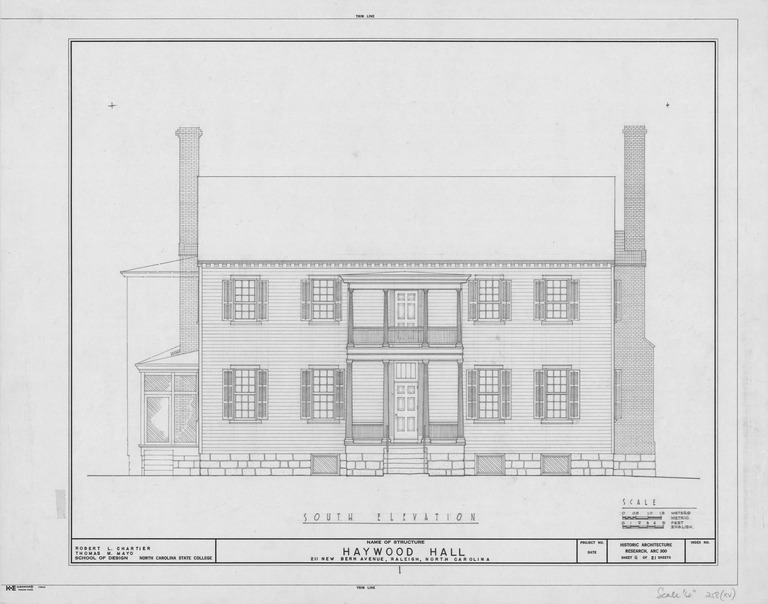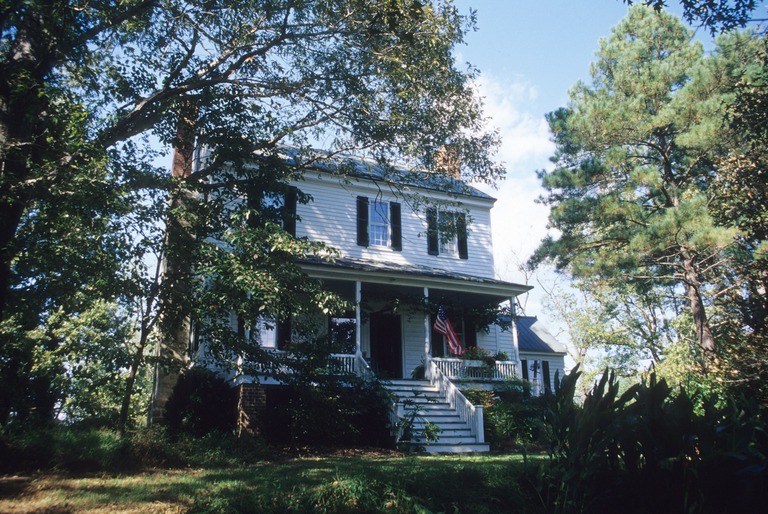Jones, William (1785?-1851?)
Birthplace:
Wake County, North Carolina, USA
Residences:
- Franklin County, North Carolina
- Wake County, North Carolina
Trades:
- Carpenter/Joiner
NC Work Locations:
Building Types:
Styles & Forms:
Federal; Georgian; Greek Revival
William Jones (1785?-1851?) was a house carpenter who worked in Wake County and possibly Franklin County in the early 19th century. Given the commonness of the name, however, it is not clear whether the William Jones, house carpenter, who worked in Raleigh ca. 1810-1817 is the same one who was working in Franklin County from 1817 onward. The following discussion may therefore treat one or two (or possibly more) house carpenters by that name.
Early in the 19th century, carpenter William Jones was active in Raleigh and Wake County. William, orphan of John Jones, was apprenticed in Wake County as a carpenter in 1805 to Foster Fort, one of several Fort Family house carpenters. Before long, in 1808, a William Jones took John Nutt, Jr., as apprentice to the carpenter’s trade and in 1810 apprenticed Berry Winningham, aged 18. In 1815 William Jones had sufficient local reputation that he certified that Willis, a slave carpenter and joiner owned by banker William Polk, had served 4 years’ apprenticeship with him and was “capable of doing very good work.” Another slave carpenter, Joe, was described by his owner, Isaac Hilliard of Halifax County, as having been trained by William Jones, evidently a mark of some accomplishment.
In 1809 William Jones and other men joined in a major Raleigh project: house carpenter William Jones, plasterer Henry Gorman (see Gorman Family), and joiner Elhannon Nutt were involved in remodeling the home of state treasurer John Haywood, Haywood Hall (ca. 1800-1805, 1809), which features an elaborate mantel in Nutt’s style and a Chinese lattice stair balustrade, which might be Jones’s work. An advertisement by Nutt listed “Capt. William Jones” as a reference. In 1810 Jones contracted to build a Principal’s House for an academy in Raleigh, which the Raleigh Star described as “a handsome specimen of the chaste, elegant, and correct style of building” which was expected to “eradicate the Vandalism that so generally pervades our architecture.” Jones also constructed a cupola on the State House built earlier by Rhodham Atkins, which featured “Chinese work”—probably a Chinese lattice balustrade. The Raleigh Star said the cupola had “a sufficient degree of elegance for the plain building” it adorned.
Also in 1810 William Jones agreed to build a frame house, 30 by 30 feet, for Calvin Jones, political figure and physician, for £327, excluding masonry and painting. This might be the Calvin Jones House in Wake Forest, but that connection is not entirely clear. Jones was also linked with Lewis Nicholson in constructing the State Bank in Raleigh, since Nicholson listed him among those to whom he was indebted on the project. In 1812 William Jones, carpenter, was listed in Wake County tax records as owning 13 slaves and 6 town lots. By 1814 Jones had “but little business on hand” and sought to “engage with any Gentleman to erect any house or houses he might wish built, on the most reasonable terms.”
In 1817 William Jones—the same man or a different one?—was in Franklin County but considering a move to Raleigh. A decade later in Franklin County, William Jones apprenticed the free black youth James Boon to his trade. After freeing him from his apprenticeship, Jones subsequently helped Boon in many ways as a friend and mentor during the latter’s career as an artisan. Jones cosigned notes for Boon, kept his accounts, wrote letters for him, and assisted him in many other ways in a relationship that continued for many years. William Jones’s only known Franklin County project is the 1838 addition to the Massenburg Plantation House, near Louisburg, where he received $689.16 for enlarging a frame house in simple Greek Revival style. Massenburg’s plantation diary recorded each workman and every day’s work.
The 1850 census listed William Jones, aged 65, as a carpenter in Franklin County without real estate. At his death in 1851, his possessions worth $188.92 included household goods and books; more than 250 individually listed carpenter’s tools and four work benches; and such building components as windows, blinds, and frames, a box of “rose blocks,” 2 columns, and some chimney pieces. More research is needed to determine whether the Wake and Franklin county William Joneses were the same man, and to learn more about the life of the man who, as a longtime friend to free black carpenter James Boon, as John Hope Franklin wrote, was one of the white citizens of the antebellum state who “did much toward making life more bearable for free Negroes.”
- Catherine W. Bishir, “Black Builders in Antebellum North Carolina,” North Carolina Historical Review, 61.4 (Oct. 1984), reprinted in Catherine W. Bishir, Southern Built: American Architecture, Regional Practice (2006).
- Franklin County Records, North Carolina State Archives, Raleigh, North Carolina.
- John Hope Franklin, “James Boon, Free Negro Artisan,” Journal of Negro History, 30 (Apr. 1945), reprinted in John Hope Franklin, Race and History: Selected Essays, 1938-1988 (1989).
- James Boon Papers, North Carolina State Archives, Raleigh, North Carolina.
- Calvin Jones Papers, Southern Historical Collection, Wilson Library, University of North Carolina at Chapel Hill, Chapel Hill, North Carolina.
- Massenburg Diary, Southern Historical Collection, Wilson Library, University of North Carolina at Chapel Hill, Chapel Hill, North Carolina.
- Elizabeth Reid Murray, Wake: Capital County of North Carolina, Vol. I, Prehistory through Centennial (1983).
- Thilbert H. Pearce, Early Architecture of Franklin County II (1988).
- Raleigh Star, May 31, 1810; Nov. 15, 1810; Nov. 9, 1817; Nov. 14, 1817.
Haywood Hall
Contributors:Dates:Ca. 1809 [remodeled]
Location:Raleigh, Wake CountyStreet Address:New Bern Place, Raleigh, NC
Status:Standing
Type:Residential
Images Published In:Catherine W. Bishir and Michael T. Southern, A Guide to the Historic Architecture of Piedmont North Carolina (2003).
Frances Benjamin Johnston and Thomas Tileston Waterman, The Early Architecture of North Carolina (1941).
Elizabeth C. Waugh, North Carolina’s Capital, Raleigh (1967).
Massenburg Plantation House
Contributors:Albert, plasterer; William Jones, carpenter; Abraham Spencer, plastering contractor; Washington, stonemason; Willis, stonemasonDates:1838 [addition]
Location:Louisburg, Franklin CountyStreet Address:NC 561, Louisburg vicinity, NC
Status:Standing
Type:Residential
Images Published In:Catherine W. Bishir, “Black Builders in Antebellum North Carolina,” North Carolina Historical Review, 61.4 (Oct. 1984), reprinted in Catherine W. Bishir, Southern Built: American Architecture, Regional Practice (2006).
Catherine W. Bishir and Michael T. Southern, A Guide to the Historic Architecture of Piedmont North Carolina (2003).
Principal's House
Contributors:William Jones, contractorDates:1810
Location:Raleigh, Wake CountyStreet Address:Raleigh, NC
Status:No longer standing
Type:Residential


